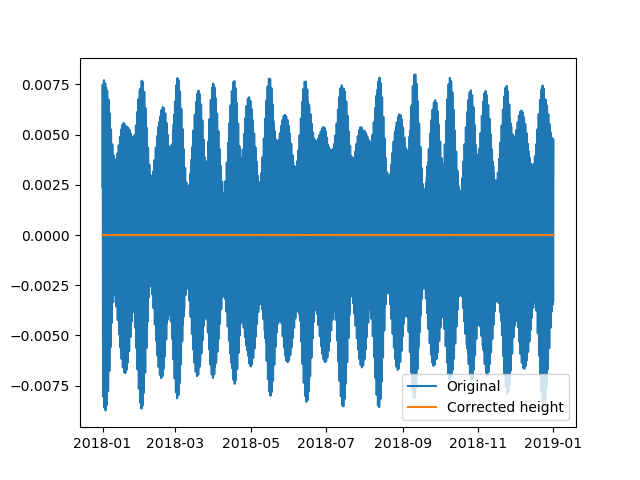Note
Go to the end to download the full example code. or to run this example in your browser via Binder
Harmonic Analysis#
This example demonstrates how to perform harmonic analysis on a signal using the
harmonic_analysis
function.
First, we import the required modules.
from __future__ import annotations
import pathlib
import matplotlib.pyplot
import netCDF4
import pyfes
The distribution contains a time series fes_tide_time_series.nc that will be used in this help.
SIGNAL = (
pathlib.Path().absolute().parent
/ 'tests'
/ 'python'
/ 'dataset'
/ 'fes_tide_time_series.nc'
)
Load the signal.
with netCDF4.Dataset(SIGNAL, 'r') as ds:
time = (ds.variables['time'][:]).astype('datetime64[us]')
h = ds['ocean'][:] * 1e-2 # cm to m
Then, we will create an instance of a pyfes.WaveTable object:
wt = pyfes.WaveTable()
By default, all components known by this object are loaded into memory. The
list of components known by this object can be retrieved using the
pyfes.constituents.known()
method.
print(pyfes.constituents.known())
['Mm', 'Mf', 'Mtm', 'MSqm', '2Q1', 'Sigma1', 'Q1', 'Rho1', 'O1', 'MP1', 'M1', 'M11', 'M12', 'M13', 'Chi1', 'Pi1', 'P1', 'S1', 'K1', 'Psi1', 'Phi1', 'Theta1', 'J1', 'OO1', 'MNS2', 'Eps2', '2N2', 'Mu2', '2MS2', 'N2', 'Nu2', 'M2', 'MKS2', 'Lambda2', 'L2', '2MN2', 'T2', 'S2', 'R2', 'K2', 'MSN2', 'Eta2', '2SM2', 'MO3', '2MK3', 'M3', 'MK3', 'N4', 'MN4', 'M4', 'SN4', 'MS4', 'MK4', 'S4', 'SK4', 'R4', '2MN6', 'M6', 'MSN6', '2MS6', '2MK6', '2SM6', 'MSK6', 'S6', 'M8', 'MSf', 'Ssa', 'Sa', 'Sa1', 'Sta', 'Mm1', 'Mf1', 'A5', 'M0', 'Mm2', 'Mf2', 'L2P', 'N2P', 'MSK2', 'SKM2', 'OQ2', '3MS4', 'MNu4', '2MSN4', '2NS2', 'MNuS2', '2MK2', 'NKM2', 'ML4', 'SO1', 'SO3', 'NK4', 'MNK6', '2NM6', '3MS8', 'SK3', '2MNS4', '2SMu2', '2MP5']
If you want to restrict the analysis to only a few components, you must provide a list to the constructor in order to specify the waves to be analyzed.
wt = pyfes.WaveTable(
[
'Mm',
'Mf',
'Mtm',
'Msqm',
'2Q1',
'Sigma1',
'Q1',
'Rho1',
'O1',
'MP1',
'M11',
'M12',
'M13',
'Chi1',
'Pi1',
'P1',
'S1',
'K1',
'Psi1',
'Phi1',
'Theta1',
'J1',
'OO1',
'MNS2',
'Eps2',
'2N2',
'Mu2',
'2MS2',
'N2',
'Nu2',
'M2',
'MKS2',
'Lambda2',
'L2',
'2MN2',
'T2',
'S2',
'R2',
'K2',
'MSN2',
'Eta2',
'2SM2',
'MO3',
'2MK3',
'M3',
'MK3',
'N4',
'MN4',
'M4',
'SN4',
'MS4',
'MK4',
'S4',
'SK4',
'R4',
'2MN6',
'M6',
'MSN6',
'2MS6',
'2MK6',
'2SM6',
'MSK6',
'S6',
'M8',
'MSf',
'Ssa',
'Sa',
]
)
The pyfes.WaveTable.keys method
allows to retrieve the list of waves defined during the construction of the
object.
print(wt.keys())
['Mm', 'Mf', 'Mtm', '2Q1', 'Sigma1', 'Q1', 'Rho1', 'O1', 'MP1', 'M11', 'M12', 'M13', 'Chi1', 'Pi1', 'P1', 'S1', 'K1', 'Psi1', 'Phi1', 'Theta1', 'J1', 'OO1', 'MNS2', 'Eps2', '2N2', 'Mu2', '2MS2', 'N2', 'Nu2', 'M2', 'MKS2', 'Lambda2', 'L2', '2MN2', 'T2', 'S2', 'R2', 'K2', 'MSN2', 'Eta2', '2SM2', 'MO3', '2MK3', 'M3', 'MK3', 'N4', 'MN4', 'M4', 'SN4', 'MS4', 'MK4', 'S4', 'SK4', 'R4', '2MN6', 'M6', 'MSN6', '2MS6', '2MK6', '2SM6', 'MSK6', 'S6', 'M8', 'MSf', 'Ssa', 'Sa']
In order to compute the astronomical angular argument, the leap seconds must
be known. The leap seconds can be obtained using the
pyfes.get_leap_seconds() function.
leap_seconds = pyfes.get_leap_seconds(time)
The different nodal corrections are then calculated from the time series to be analyzed:
f, vu = wt.compute_nodal_modulations(time, leap_seconds)
These coefficients are used by harmonic analysis to determine the properties
of the different tidal waves defined during the construction of the instance.
w = wt.harmonic_analysis(h, f, vu)
This result can then be used to determine a tidal height for the analyzed time series:
h_tide = wt.tide_from_tide_series(time, leap_seconds, w)
Finally, we can visualize the original signal’s height adjusted by the tidal height derived from harmonic analysis. The outcome is zero because the analyzed signal originates from the tidal model using identical waves as those in the harmonic analysis.
matplotlib.pyplot.plot(time, h, label='Original')
matplotlib.pyplot.plot(time, h - h_tide, label='Corrected height')
matplotlib.pyplot.legend()

<matplotlib.legend.Legend object at 0x7f8238241ad0>
Total running time of the script: (0 minutes 5.092 seconds)